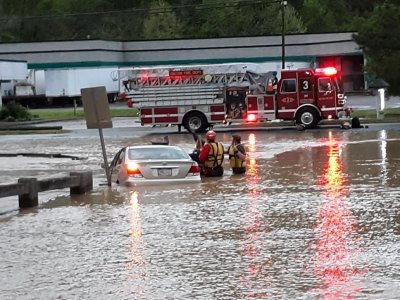Stormwater Solutions Are Essential For Dalton's Future
When it rains, it pours.
If you’ve ever found yourself near Mill Creek on Coronet Drive or Willowdale Road during a hard rain in Dalton, you know that it doesn’t take too much to turn a storm into a flood. When rain events begin to last hours instead of minutes, those areas are among the city’s most flood-prone. Even when those flooding events are small, they can cause big problems – property damage, road closures, and lost time for businesses are just a few of the issues that can be caused by stormwater. That’s why the City of Dalton is working to address its stormwater management.
Obviously, when rain falls it soaks into the ground. When too much rain falls and the ground becomes too waterlogged to allow more to soak in, the rain either runs off and pools in low lying areas or it runs off into streams, rivers, and lakes. When the land is developed and cities grow with concrete parking lots and roads, large buildings with roofs, and other development covering the ground with impermeable surfaces, the water has less room to soak into the ground which causes more runoff and storms that ordinarily wouldn’t cause flooding instead become more serious. In the 1970s and 80s, developers began to consider the impact of development on stormwater management, but the federal government didn’t require cities the size of Dalton to have stormwater management plans until 2006. That’s more than 150 years of development without a plan to address the flooding concerns it would cause.
“Ever since then (2006) we’ve been having to manage our stormwater program, our pipes, our drainage structures,” said City Administrator Andrew Parker, who served as Public Works Director until August and has been working on stormwater issues. “What we’re looking to do now is be a little more proactive with our planning effort to develop a strategy throughout the city to deal with some of the longstanding issues like flooding.”

Above: City Administrator Andrew Parker
Over the past few years, the City of Dalton has been working with a company called Arcadis to study stormwater drainage in the city to identify problem areas and to study possible solutions to reduce or eliminate those problems. This work has already led to the completion of some projects, including the creation of a new detention pond near the Covie Ridge subdivision to alleviate some flooding concerns in that neighborhood.
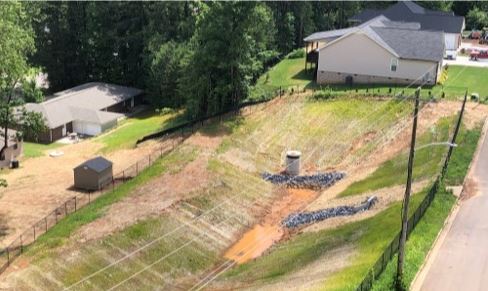
Above: The new stormwater detention pond at Covie Ridge
Another project completed recently is the Brookwood Drive flood storage project. The area surrounding Brookwood Park has historically been a problem area for floodwater, with water draining off of surrounding hills often causing Tar Creek to flood into Brookwood Park and the surrounding neighborhood. The solution was to acquire the house at 915 Brookwood Drive and demolish it and grade the lot to restore the land’s ability to better handle stormwater.
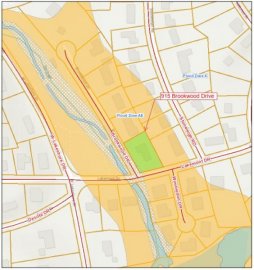

Above left: The property at 915 Brookwood Drive is highlighted in green in the yellow highlighted flood zone near Brookwood Park; Above right: an aerial view of the demolition and grading of the flood plain restoration project at the property
“Basically, what we’ve done is we’ve cleared off the house and put basically a flood storage area for water to stage up at to attenuate the flow before it’s conveyed into the main channel,” said Jackson Sheppard a project engineer with the Dalton Public Works Department who has been focusing his work on stormwater management. “You have all the water that’s coming down off of Stoneleigh Drive and off of Lakemont and coming off and collecting in the channel here, this is just an area that allows the water to slow down and make sure the creek doesn’t take it all at once.”
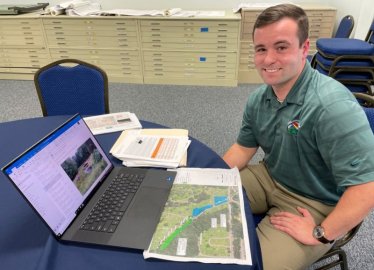
Above: Project Engineer Jackson Sheppard
Another project in the planning stages will require a little more work than simply knocking down a house and grading a vacant lot, but it is expected to have greater benefits for the residents of the Murray Hill neighborhood and visitors to Dalton’s West Hill cemetery.
Property owners in the area downhill from the cemetery have had problems with flooding and erosion for many years. Work has already been done to create detention structures in a basin near the intersection of Greenwood Drive and Emery Street with a large area of land set aside with stones to slow the flow of water. Now another project is planned to install a Regenerative Stormwater Conveyance (RSC) in the slope above Evans Whitener Drive in the cemetery.
“It is a method of in-line stormwater detention that is a series of step pools and check dams essentially,” Sheppard said, describing the RSC. “Basically you’re going to have individual pools that are able to collect water before it gets to our existing dry detention storage basins and from there there’s a series of check dams that further slows the water and enables it to stage up a little bit.”
“It slows the water down and increases the storage as well as another benefit of doing this which is allowing the water to infiltrate, and when you have your water that’s infiltrating that’s going to improve water quality to the drainage basin as a whole,” Sheppard said. “So that’s on top of just alleviating the flooding concerns, this can potentially improve water quality of this drainage basin.”

Above: A map showing the proposed placement of the RSC in the cemetery highlighted in green, with existing and expanding detention areas highlighted in blue
Sheppard also noted that RSC projects also are attractive, with the appearance of a series of pools cascading down a hillside, something that is important in the cemetery which is one of the most beautiful places in the city.
“Part of Arcadis’ specialty is developing implementations that are pleasing to the eye which is also an important factor,” Sheppard noted.
Once the RSC structures are installed, there would be additional work in the existing dry detention basin in the cemetery to try to further reduce water flow.
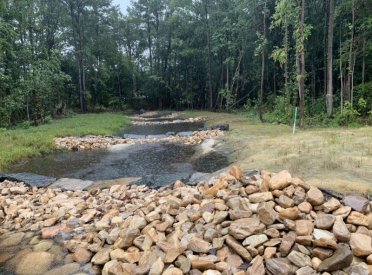
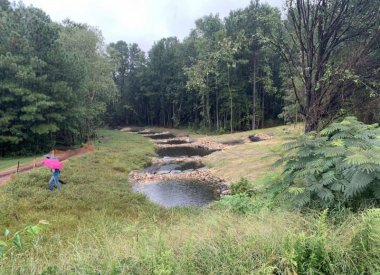
Above: Examples of how a Regenerative Stormwater Conveyance might look
There are other projects being studied including work along Glenwood Avenue in the commercial and industrial area near the intersection of Glenwood Avenue and Matilda Street which is prone to flooding. Smaller scale projects like these can lead to cumulative gains for the city over time as work continues to address stormwater.
The city is also working with Arcadis to develop an overall Flood Abatement Plan, which will be delivered after the completion of a large-scale study of the community as a whole using LIDAR data and other data to create a full scale picture of the city’s water system, pinpointing areas of concern with plans to address them.
There’s also the issue of maintaining the structures that are already in place to address stormwater. The Public Works Department and Arcadis completed a survey of all of the city’s pipe and gutter infrastructure earlier this year and found that many pipes, particularly corrugated metal pipes, are in danger of failure due to rusting and age. This could lead to erosion under critical road ways and failure of those roads. The City has created a prioritized list of pipes that need to be addressed. Fortunately, there are relatively simple fixes for the corrugated metal pipes. One method is called centrifugally casted lining. This technique involves placing machinery into the pipe to spray a concrete polymer mix onto the existing pipe and which will dry to a certain thickness to reinforce the pipe increasing its strength and longevity, eliminating the need to replace it entirely.

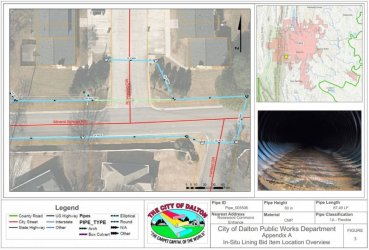
Above: A view of the rusting corrugated metal pipe underneath Rosewood Circle at Mineral Springs Road and a diagram showing its placement
As the City works to address longstanding problems, City leaders are making sure not to create new ones. Ordinances adopted since 2006 mandate that new developments will include stormwater control offsets to make sure they don’t create new flooding issues. And new projects being planned by the City will all include “green infrastructure” technologies such as natural bioswales and types of sidewalk materials that are designed to allow greater infiltration of water.
“A good example of that would be the Market Street streetscape improvements, we’ve got green infrastructure techniques built into that project,” Parker said. “We’ve got bioswales within the right of way, depressed tree planning areas with sod to encourage infiltration. Every project we perform from here on out we’ll always do a self-test to make sure we’re addressing the stormwater runoff caused by the project or intensified by it.”
It took 150 years for the City of Dalton to grow into what it has become, so fixing the stormwater problems that developed along the way won’t happen overnight. But it’s certainly important to make sure we fix these problems.
“This is a huge undertaking to address these flooding issues, it’s not something that’s going to happen overnight but it’s certainly my priority,” said Sheppard. “It’s very challenging, both trying to get the cooperation where needed as well as trying to find solutions in areas that the city already owns, you can implement things. It’s going to be a long-term thing.”
“We want to maintain the values of property for our residents,” said Parker when asked why tackling stormwater problems is crucial for Dalton. “Every time a road is flooded that’s lost opportunity for economic impact. We’re a heavy industrial city so every time a road is closed that means freight is not getting from Point A to Point B, workers are not getting from Point A to Point B and also as I said, private property owners, every day that they have issues with water that’s potentially a long-term challenge for them.”
“We hope to continue implementing several of these projects quickly, but to have a guiding plan to carry us into the future on projects and development is so critical so we don’t make some of the mistakes of the past.”

